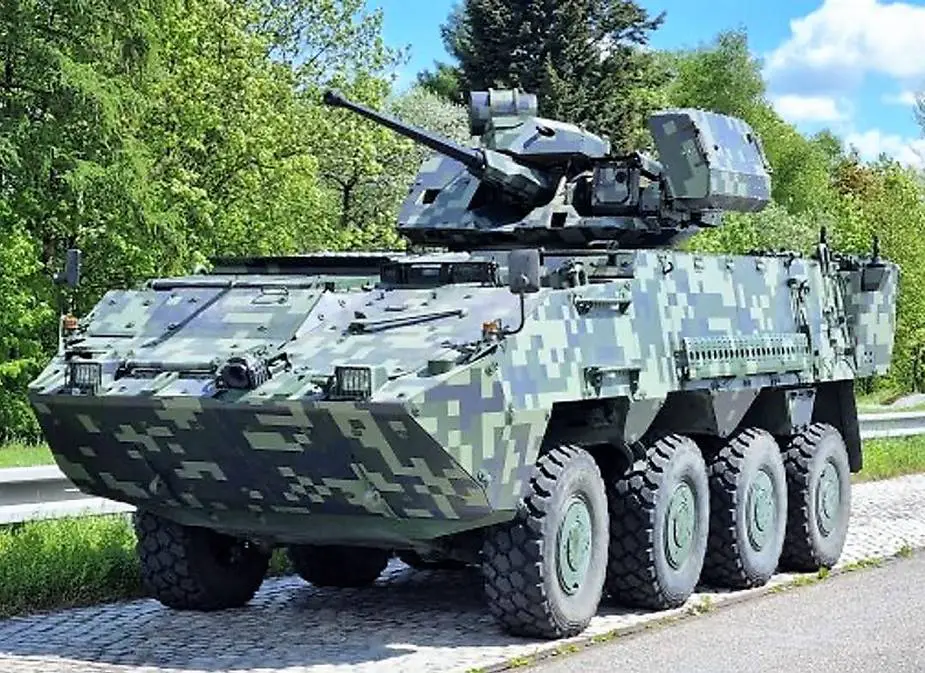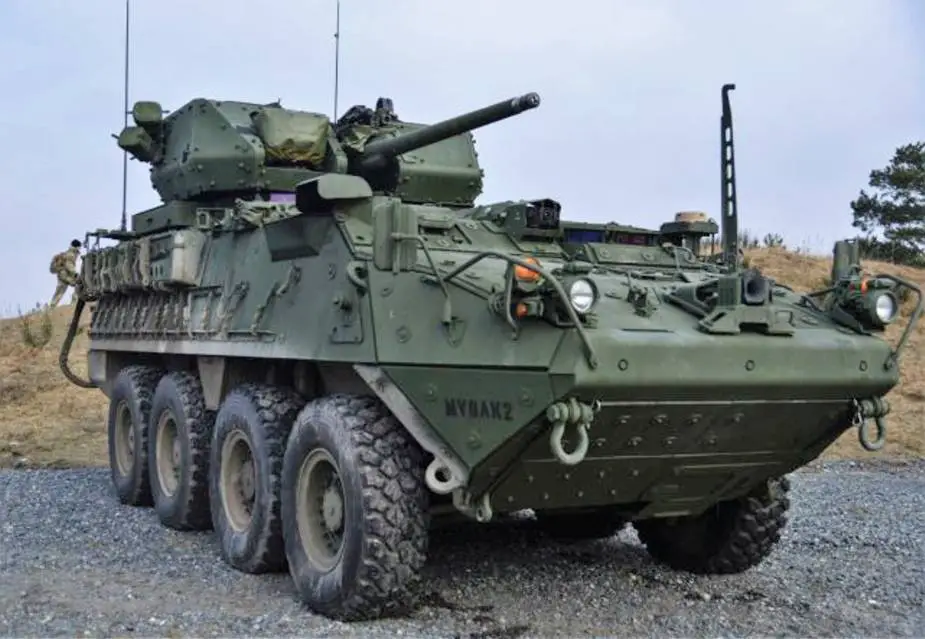Slovak Defense to evaluate wheeled competitors for IFV fleet
The Armed Forces of the Slovak Republic have achieved a unique opportunity to obtain modern Infantry Fighting Vehicles (IFV) in two procurement programs. In addition to the fact that the Ministry of Defence plans to purchase 228 tracked armored vehicles, it also intends to purchase as many as 500 wheeled armored vehicles in different variants.
Follow Army Recognition on Google News at this link

Patria AMV XP displayed at IDEB, Bratislava (Picture source: AH)
The Ministry of Defense of the Slovak Republic proposes the purchase of 500 8x8 armored combat vehicles in five phases of the project. The estimated upper limit of investment costs in the years 2022 to 2035 reaches 2.39 Bn EUR (VAT incl.). The investment costs for the first phase are estimated by the Ministry of Defense of the Slovak Republic at 332 Mn EUR (VAT incl.). In the first phase, the Ministry of Defense of the Slovak Republic plans to choose a platform and buy the first 76 vehicles in three versions: combat, command, medical. The following phases of the project will be subject to options and their implementation will be subject to separate evaluations and approval by the government.
After having presented in detail the tracked vehicles participating in the competition, it is now time to take a closer look at wheeled vehicles in the same phase – conquering the place of the best choice for the Armed Forces Slovak Republic.
There are some requirements for the procurement process: The acquisition requires a sufficiently high level of participation of the domestic industry in the manufacture of new vehicles. An amphibious capability is no longer a requirement for procurement, but an option. Potential candidates for the competition include the Patria AMV produced by the Finnish company Patria, the Corsac (Pandur II) 8x8 by Steyr-Daimler-Puch Spezialfahrzeuge under General Dynamics European Land Systems (GDELS) license, the Piranha V from European GDELS, and the Stryker by GDLS USA.
Patria AMV
Patria AMV provides the performance and features of a multi-role vehicle. This combat-proven vehicle is available in three different models. The basic model provides the platform for the following variants: Armoured Personnel Carrier (APC), Infantry Fighting Vehicle (IFV), command vehicle, ambulance, reconnaissance vehicle, Anti-Tank Guided Missile vehicle (ATGM), Armoured Repair and Recovery Vehicle (ARRV), and finally, the 120 mm Patria Nemo mortar system.
The high Roof model provides extra space at the rear of the vehicle (34 cm higher than the basic model), which is ideal if the vehicle is used as a command, C4I, ambulance, or workshop vehicle. The Heavy Weapon Platform has been optimized to carry large-caliber weapon systems such as the 120 mm AMOS mortar system or the 105/120 mm Mobile Gun Systems (MGS).
AMV’s combat weight can reach 32 tons, which gives it a usable payload of 15 tons. The high payload with its large internal volume allows the transport of weapon systems, ammunition and crew equipment. The characteristics of the vehicle enable the use of any weapon system required for engaging moving targets rapidly and with pinpoint accuracy. AMV´s mine protection is STANAG level 4a/4b, and the ballistic protection level is up to STANAG level 5. The optimized shape provides a low radar and thermal signature.
AMV has an independent hydropneumatic suspension system. The strong overall structure of the vehicle enables high-speed, off-road driving. The vehicle is easy to use, and its mobility is based on a high-performance driveline. Integrated Terrain Control System (ITCS) and optional rear-axle steering improve maneuverability. AMV's electrical power generation is designed to match the future requirements for C4I, Battlefield Management and Situational Awareness Systems, Health and Usage Monitoring System (HUMS) together with the vehicle's digital backbone. The vehicle has an NGVA (NATO Generic Vehicle Architecture) interface and is fully NATO-compatible. AMV is optionally amphibious; the maximum swimming speed is 10km/h.
Technology transfer and local manufacturing are essential parts of Patria’s business model. Patria has successfully transferred AMV technology through industrial participation and production in several countries, such as in Poland, Slovenia, Croatia, and South Africa. Over 1,600 vehicles have already been purchased in 8 different countries; 4 of them are NATO countries. The AMV product family has been combat-proven since 2007, namely in Afghanistan where it has been the only combat-proven vehicle among the three current candidates.

Pandur II, TDV (Tatra Defence Vehicle) (Picture source: armadninoviny.cz)
Corsac / Pandur II
Corsac 8x8 is an improved model of General Dynamics’ Pandur II armored personnel carrier. The Corsac infantry fighting vehicle has been developed by the Austrian company Steyr-Daimler-Puch Spezialfahrzeuge, which has been owned by GDELS since 2003. In Slovakia, Corsac is marketed by Czechoslovak Group/MSM Group under GDELS license.
Czech and Portuguese versions of the Pandur II include the following variants: Armoured Personnel Carrier (APC), Infantry Fighting Vehicle (IFV), command vehicle, ambulance, surveillance vehicle, Anti-Tank Guided Missile vehicle (ATGM) and Armoured Repair and Recovery Vehicle (ARRV).
Corsac is powered by a Cummins turbodiesel engine. The vehicle has a coil spring suspension (first two axles) and hollow rubber springs (two rear axles). Corsac’s combat weight is 23 tons, including 8 tons of payload including eight mounted troops. Corsac has a crew of three (commander, gunner and driver). The vehicle is protected at STANAG level 3 and it has a maximum level 3 a/b mine protection.
Corsac’s maximum combat weight with payload is inferior to the AMV’s or Piranha V’s one. Corsac is also a smaller vehicle: it has a length of 7.43 m, a width of 2.67 m, and a height of 2.95 m. It has a smaller wheel size and less growth potential than the other candidates. Corsac is optionally amphibious, and the maximum swimming speed is 10km/h.
Corsac can adopt various unmanned/manned turrets armed with up to a 30mm automatic gun. Corsac has been purchased by the Czech Republic, Portugal, Indonesia, and The Philippines. The total number of vehicles ordered is around 400.

Romanian Piranha V with Israeli UT30MK2 (Picture source: GDELS)
Piranha V
The Piranha V is the fifth generation of the Mowag Piranha family. It was designed by General Dynamics European Land Systems - Mowag GmbH. Piranha V includes the following variants: Armoured Personnel Carrier (APC), Infantry Fighting Vehicle (IFV), command vehicle, ambulance and mortar version.
Piranha V’s maximum combat weight is 33 tons, including 14.5 tons of payload that includes the crew and eight mounted troops. Piranha V has a high level of protection, an up-rated drivetrain to cater for weight growth, greater internal volume, improved mobility, enhanced power and power management and a modern, open, electronic architecture. The protection level is up to level 5 and mine protection is up to level 4a/b. Piranha’s design incorporates shaped hull plates to optimize the resistance to blasts, spacing in the add-on armor and surface coatings to minimize the thermal and radar signatures.
Steering is implemented by the two front axles and the rear axle. The vehicle features a hydropneumatic suspension. Piranha V is available with an MTU or Scania turbodiesel engine. Weapons systems include a 12.7mm MG, a 25mm, 30mm or low-recoil 105mm gun. Piranha V’s size is approximately the same as that of AMV: 8 m long, 3 m wide, and 2,3 m high. Piranha V is not amphibious. It has been purchased by Denmark, Spain, Romania and Switzerland. The total number of vehicles ordered is around 900.

Stryker Dragoon with Norwegian combat module Protector RT40 (Picture source: U.S. Army)
Stryker
The Stryker ICV (Infantry Carrier Vehicle) is a family of 8x8 armored fighting vehicles derived from the Canadian LAV III. Stryker vehicles are produced by General Dynamics Land Systems for the U.S. Army. It is a four-wheel-drive (8×4) but can be switched to an all-wheel-drive (8×8).
The vehicle comes in several variants with a common engine, transmission, hydraulics, wheels, tires, differentials and transfer case. The M1130 Command Vehicle and M1133 Medical Evacuation Vehicle have an air conditioning unit mounted on the back.
In November 2003, 311 Stryker vehicles were deployed in the Iraq War, where they saw mixed success. Never designed for front-line combat, the vehicles were nevertheless pressed into counterinsurgency roles for which there was an unmet need. A leaked U.S. Army report from December 2004 said the Stryker was "effective and survivable only with limitations for use in small-scale contingencies". The report, written from feedback from Stryker personnel in Mosul, described a litany of design flaws.
In June 2021, the U.S. Army selected the Oshkosh Defense team, which includes Pratt Miller Defense and Rafael Advanced Defense Systems, to integrate the 30 mm MCWS onto the Stryker Double-V Hull Infantry Carrier Vehicle (ICVVA1). This upgrade will provide increased lethality, accuracy, and range while maintaining the mobility and survivability of the Stryker ICVVA1.
Will innovation or experience be the deciding factor?
The Slovak Ministry of Defense announced in January 2022 that it had received bids from five countries. In fact, there will be four types of vehicles to choose from; two countries have submitted an offer for licensed production of the same chassis: specifically, the Czechs with a Pandur vehicle, the Finns with a Patria vehicle, the Americans with a Stryker vehicle, and the Romanians with a licensed version of the Swiss Piranha vehicle and finally the Spaniards with a Dragon vehicle, which is also a licensed production of the Piranha vehicle.
Today, ground technology is probably the weakest component in the Slovak Armed Forces. The tenders that are currently taking place at the Ministry of Defense should bring a significant number of modern armored vehicles to Slovak soldiers for the first time since the end of the Cold War. The involvement of the Slovak industry can ultimately be an important factor. The Czech Pandur and Finish Patria promise a large portion of the localization to Slovak industrial companies.
When comparing the vehicles submitted to the tender program, all are suitable for the post-cold-war upgrade. The Armed forces and the Ministry of Defense will need to wonder what modernization factor is important to them. Some of the vehicles have seen the 1990s while others use the latest technologies (the first Mowag’s Piranha family was introduced in 1974). Price will of course be an important factor too.
Who will make it?
All the contenders to renew Slovakia’s 8x8 fleet have positive marks but also drawbacks. Ultimately, the result may come down to whether or not decision-makers wish to play it safe with the older design of Pandur, Stryker or Piranha, or opt for the newest technology of Finish Patria. Whatever the outcome of the modernization will be, the country’s armed forces are hoping for the arrival of a vehicle type with which they can work for decades to come.


























